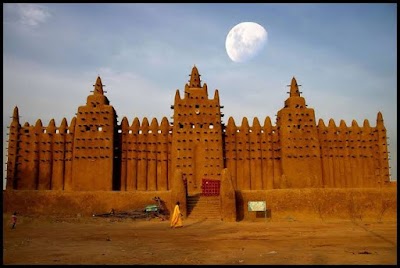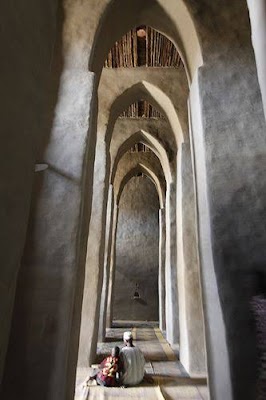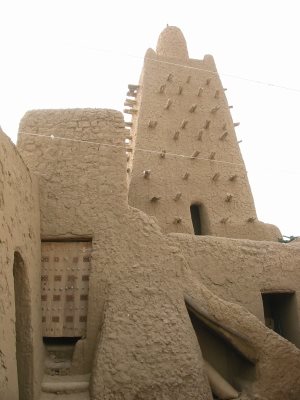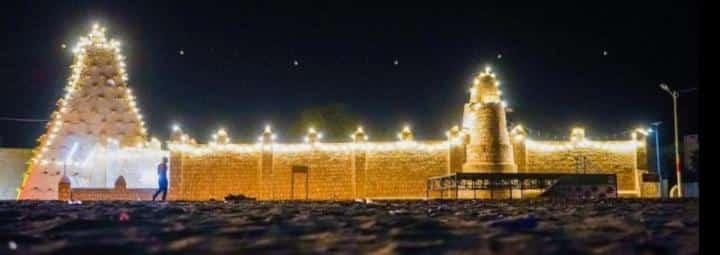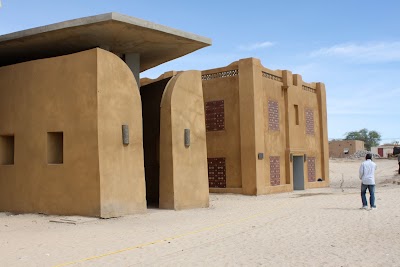Great Mosque of Djenne (المسجد الكبير في جيني)
Overview
The Great Mosque of Djenné is an iconic and awe-inspiring structure that stands majestically in the town of Djenné, located in the Tombouctou Region of Mali. Recognized as one of Africa's most famous landmarks, this architectural marvel serves not only as a significant religious site but also as a symbol of the region's rich cultural heritage and history.
The origins of the Great Mosque can be traced back to the 13th century when it is believed that the first mosque was constructed around 1200 AD by Sultan Koi Konboro, who embraced Islam and set out to build a grand place of worship. However, the magnificent structure that captivates visitors today was built later, between 1906 and 1907, by the French colonial administration, adhering to the traditional Sudano-Sahelian architectural style.
One of the most striking features of the Great Mosque is its construction material. The entire building is crafted from sun-dried mud bricks, known locally as "ferey," along with mortar and a plaster made from mud and rice husks. This traditional material not only lends the mosque its unique earthy appearance but also connects it to the environmental and cultural context of Djenné. The mosque's design showcases conical, buttressed towers and pillars adorned with bundles of palm sticks, known as "toron." These elements serve both decorative and practical purposes, providing scaffolding for necessary annual maintenance.
Spanning an impressive 75 by 75 meters, the Great Mosque is the largest mud-brick building in the world. Its expansive courtyard can accommodate thousands of worshippers who gather for Friday prayers and significant Islamic celebrations. Inside, the mosque features three large towers and numerous arches, creating a sense of openness and tranquility that reflects its purpose as a sanctuary for spiritual contemplation.
The significance of the Great Mosque extends beyond its role as a place of worship. It has long been a center of learning and scholarship, with Djenné historically recognized as one of the key intellectual hubs of the Sahel region. Scholars from across West Africa traveled to Djenné to study and teach, contributing to the dissemination of knowledge and Islamic culture throughout the continent. This legacy of scholarship continues today, as residents honor their heritage through education and conservation initiatives.
An intriguing aspect of the Great Mosque of Djenné is its annual plastering festival, known as "La Crepissage." Each year, the local community comes together in a vibrant and festive event to repair and reapply the mud plaster that protects the mosque. This celebration is not only a practical necessity for maintaining the structure but also a significant cultural occasion that fosters a sense of shared identity and pride among the community.
In recognition of its cultural and historical importance, the Great Mosque of Djenné was designated a UNESCO World Heritage Site in 1988. This acknowledgment plays a vital role in preserving the mosque and promoting appreciation for its architectural and cultural legacy. Visitors to the mosque are often struck by the incredible craftsmanship and the rich history that resonates throughout every wall and tower.
For tourists planning to visit the Great Mosque of Djenné, there are several important considerations. As an active place of worship, visitors are expected to dress modestly and respect local customs and practices. Guided tours are highly recommended, as they provide valuable insights into the mosque's history, architecture, and cultural significance. While photography is generally permitted from the exterior, it is advisable to seek permission before taking photos of people, especially during religious events and ceremonies.
A visit to the Great Mosque of Djenné offers an enriching experience, providing a glimpse into the extraordinary heritage of Mali and the enduring spirit of its people. It is not just an opportunity to admire an architectural wonder but also a chance to witness the vibrant cultural traditions that surround it. Whether you're an architecture enthusiast, a history buff, or a traveler in search of meaningful experiences, the Great Mosque of Djenné is sure to leave a lasting impression.


